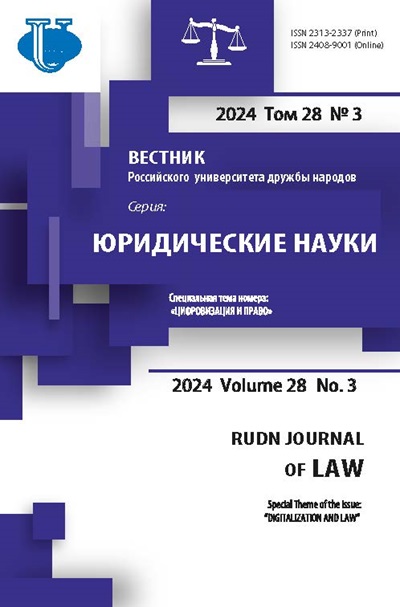ПРАВОВЫЕ ОСНОВЫ ГОСУДАРСТВЕННОЙ ПОЛИТИКИ РОССИИ В XVI-XVIII ВЕКАХ В ОТНОШЕНИИ КОРЕННЫХ НАРОДОВ НА ПРИМЕРЕ МОРДВЫ
- Авторы: Сушкова Ю.Н.1
-
Учреждения:
- Национальный исследовательский Мордовский государственный университет им. Н.П. Огарева
- Выпуск: Том 24, № 3 (2020)
- Страницы: 591-607
- Раздел: ИСТОРИКО-ПРАВОВЫЕ ИССЛЕДОВАНИЯ
- URL: https://journals.rudn.ru/law/article/view/24563
- DOI: https://doi.org/10.22363/2313-2337-2020-24-3-591-607
Цитировать
Полный текст
Аннотация
Актуальность исследования обусловлена уникальностью устройства Российского государства как многонационального и многоконфессионального. Включение народов в единое государственно-правовое пространство обусловило необходимость выработки соответствующей национальной правовой политики. В связи с этим данная статья направлена на раскрытие правовых основ государственной политики России в XVI-XVIII вв. в отношении коренных народов на примере Мордвы. В статье освещается наиболее значимые аспекты государственной национальной политики, затрагивающие положение мордовского народа. Анализируется законодательство XVI-XVIII вв., действовавшее в отношении «инородцев» и определявшее особенности их адаптации в составе России. Основными методами к исследованию проблемы являются формальноюридический и историко-правовой в сочетании с социокультурными и юридико-антропологическими теоретико-методологическими подходами, позволившими выделить наиболее существенные меры государственной политики по адаптации Мордвы в составе Российского государства в XVI-XVIII вв. Материалы статьи представляют практическую ценность для совершенствования законодательства в области межнациональных отношений, укрепления основ федерализма как важнейшей характеристики Российского государства.
Ключевые слова
Об авторах
Юлия Николаевна Сушкова
Национальный исследовательский Мордовский государственный университет им. Н.П. Огарева
Автор, ответственный за переписку.
Email: yulenkam@mail.ru
доктор исторических наук, доцент, зав. кафедрой международного и европейского права, декан юридического факультета
430005, г. Саранск, Российская Федерация, ул. Большевистская, д. 68Список литературы
- История Мордовии: с древнейших времен до середины XIX века / Под ред. проф. Н.М. Арсентьева и проф. В. А. Юрченкова. Саранск: Изд-во Мордов. ун-та, 2001. 344 с
- Abercromby, J. (2010) The Beliefs and Religious Ceremonies of the Mordvins (Folklore History Series). Pierides Press.
- Barber, N.W. (2006) Legal Pluralism and the European Union. European Law Journal, Vol. 12, No. 3, 306-329.
- Berman, P.S. (2012) Global Legal Pluralism: A Jurisprudence of Law beyond Borders. Cambridge University Press.
- Franz and Keebet Von Benda-Beckmann (ed.) (2008) Dynamics of Plural Legal Orders: The Journal of Legal Pluralism and Unofficial Law. Ed. Franz and Keebet Von BendaBeckmann. Lit Verlag.
- Janurik, B. (2015) The emergence of gender agreement in code-switched verbal constructions in Erzya-Russian bilingual discourse. Stolz, Ch. Language Empires in Comparative Perspective. Walter de Gruyter GmbH & Co KG. 199-218
- Документы и материалы по истории Мордовской АССР / Под ред. Ин-та истории Акад. наук СССР; (Отв. ред. Б. Д. Греков и проф. В. И. Лебедев); Морд. н.-и. ин-т языка, лит. и истории при СНК МАССР. Саранск: МНИИЯЛИ, 1939-1952. Т. 1 (Ч. 1): V в. до н. э. VIII в. н. э. 1940. 432 с
- Helfand, M.A. (2015) Negotiating State and Non-State Law: The Challenge of Global and Local Legal Pluralism. Cambridge University Press
- Христофоров И.Я. О старинных рукописях в Симбирской Карамзинской библиотеке // Тр. IV Археологического съезда в России. Т. 2. Казань, 1896. С. 27-42
- Kirmse, S.B. (2019) The Lawful Empire: Legal Change and Cultural Diversity in Late Tsarist Russia. Cambridge University Press
- Русская историческая география: Курс лекций, чит. в 1908-09 уч. / [соч.] С.К. Кузнецовым. Мордва. Москва: Печатня А. И. Снегиревой: Тип. Пожидаева, 1912. 73 с
- Мельников П.И. Очерки мордвы. Саранск: Мордов. кн. изд-во, 1981. 136 с
- Михеева Ц.Ц., Трикоз Е.Н., Графшонкина А.А., Андреева П.Н. Обзор II Международной научной конференции «Право - явление цивилизации и культуры». Россия, Москва, РУДН, 29-30 марта 2019 // Вестник РУДН. Серия: Юридические науки. 2019. Т. 23. № 3. С. 455-477
- Мокшин Н.Ф. Этническая история мордвы. Саранск: Мордов. кн. изд-во, 1977. 280 с
- Мокшин Н.Ф. Мордва в истории России // Русская история. 2012. № 2 (21). С. 38-43
- Немытина М.В. Цивилизационно-культурный подход в правоведении // Вестник Университета имени О.Е. Кутафина. 2017. № 4. С. 28-40. doi: 10.17803/23115998.2017.32.4.028-040
- Provost, R., Sheppard, C. (eds.) (2013) Dialogues on Human Rights and Legal Pluralism (Ius Gentium: Comparative Perspectives on Law and Justice Book 17). Ed. René Provost, Colleen Sheppard. Edition, Kindle Edition. Springer
- Сафаргалиев М.Г. К истории татарского населения Мордовской АССР (о мишарях) // Тр. Мордовского НИИЯЛИ. Вып. 24. Сер. историческая. Саранск, 1963. C. 64-79
- Сушкова Ю.Н. Обычное право мордвы. Саранск: Изд-во Мордов. ун-та, 2019. 496 с. Taagepera, R. (2000) The Finno-Ugric Republics and the Russian State. Taylor & Francis
- Тихомиров М.Н., Епифанов П.П. Соборное уложение 1649 года. М.: Изд-во Москов. ун-та, 1961. 444 c
- Томсинов В.А. Соборное уложение 1649 года как памятник русской юриспруденции // Правоведение. 2007. № 1. С. 162-188
- Документы и материалы по истории Мордовской АССР. Мордовский научноисследовательский институт языка, литературы и истории при СНК МАССР; Под ред. Института истории АН СССР; Под ред. А. И. Яковлева (науч. ред.) и др. Том 3. Часть 1 / Саранск: Мордгиз, 1939. 345 с
- Various (2010) Marriage Customs Among Early Mordvins, Slavs, and Manchus. Pierides Press
















